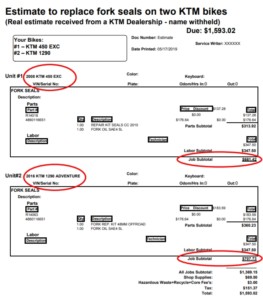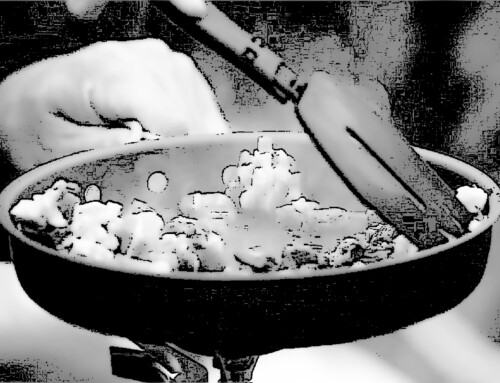Wanna spend $700 to replace your fork seals? Uhmmm – I don’t. I’d rather spend $50 to protect those seals so they last as long as possible.
I contacted a friend that works as a service writer at a local KTM shop and asked him to work up the costs to replace the seals on my KTM 450, and the seals on a friend’s 1290. This photo shows the actual estimate (dealer info redacted, but the costs are there for your inspection.) If you can’t see the details, the costs are about $700 for either bike.

How long will a set of fork seals last? That depends on how and where the bike is ridden and the conditions you encounter on the trail. Seals might last a few days or they could last years. Why is that?
Seals don’t generally fail because they “wear out”, instead they fail because something damages the seal surface, which then leads to oil blowing past the seals. When your seals fail the forks turn into a giant pair of pogo sticks. No damping, just bouncing, with oil spewing on the rotors, which means no front brakes. And if one seal fails, you’re well advised to replace seals on both forks.
What damages fork seals? Dirt, grit, mud, etc. Every time your forks move, the seals swipe up and down on the chrome sliders, acting like circular windshield wipers that swipe the crud away. If you’re unlucky a grain of sand works its way inside the seal, cutting the edges. That grain opens up a path for more crud, and pretty soon the entire seal is toast. Plus those grains of sand will probably score the slider, which means a re-polish or a total replacement.
Another cause of seal failure is mud. Mud is a slurry of fine-grained minerals that act like coarse polishing compound. Over time that slurry wears down the rubber and the seals fail.
So…. what can you do to eliminate fork seal failure? The answer is simple – protect the sliders (and the seals) so mud, dirt, sand, water, and other crud never has a chance to do it’s thing.
Forksaver Fork Protectors attach to the large fork tube with a silicone sealing ring. There’s a waterproof nylon sleeve that fits over the chrome slider, and that sleeve is held at the bottom by a specially engineered O-ring. As the forks move up and down the nylon sleeve gathers and retracts like an accordion. Because the sleeve is flexible there’s no “stiction” which would affect the fork’s performance.
What this gives you is a mud-proof, sand-proof, water-proof enclosure that keeps crud off the sliders, and that keeps your seals in perfect shape. When the seals are clean and dry they’ll last for years.
Don’t confuse Forksavers with other fork protection systems, like neoprene or zip-on foam sleeves. Those designs can “pack-up” with mud, their porous foam collects grit, and they generally cause more problems than they solve.
Forksavers are available for conventional and upside-down forks. The large tube diameter determines the model for your forks. We also have special kits designed for the Honda AT, the BMW 800, and the KTM 1190 and 1290.
Let’s go back to that dealer estimate. I know that shop and it’s a fair estimate, based on their shop rate and costs of doing business. Many riders do their own work and don’t want to pay dealer prices, so they tackle the job themselves. For you intrepid garage mechanics, you’ll still need special tools to remove the old seals and install the new ones. It can be done in your garage if you know what you’re doing. But you”ll still spend more on those new seals than you will on a set of Forksavers.





